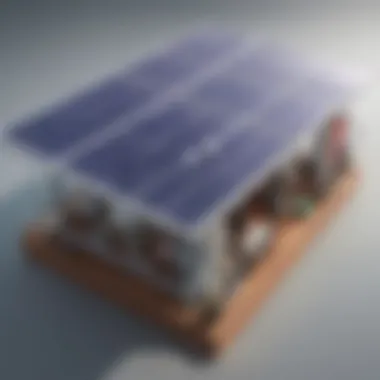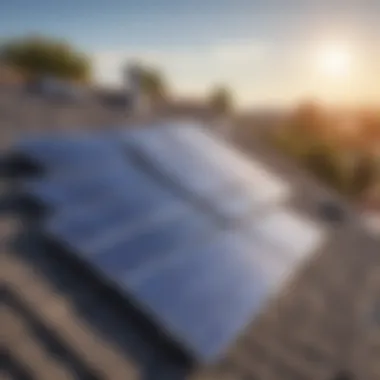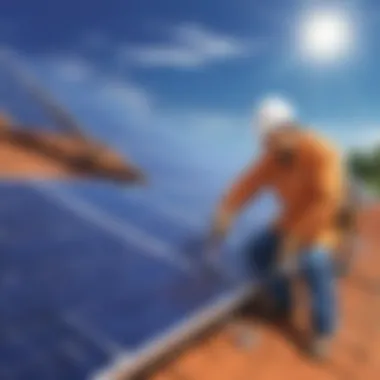Building Your Own Solar Panel System: A Guide


Intro
Constructing a solar panel system can seem daunting at first. However, with proper guidance and understanding, it becomes much more accessible. This article serves as a roadmap for anyone interested in the world of solar energy. We will cover essential components, installation procedures, and ongoing maintenance strategies to ensure your solar panel system operates effectively. Understanding how solar panels work and what you need to build one can pave the way to a sustainable energy future for households and communities alike.
Science Fun Facts
Solar energy is not only a solution for effective and sustainable power. It comes with a variety of interesting facts that underline its significance.
- The Sun's Energy: Every hour, the sun radiates enough energy to satisfy global energy needs for an entire year.
- Solar Panel Lifespan: Modern solar panels can last over 25 years and still maintain significant efficiency. This translates into long-term savings on energy bills.
- Earth’s Resources: Solar energy is a renewable resource. While fossil fuels are finite, solar power can be harnessed as long as the Sun exists.
Did you know? More than 1 million solar panels are installed in the United States every 2.5 years. This growth reflects a shift towards cleaner energy production.
Essential Components of a Solar Panel System
To successfully construct a solar panel system, it is crucial to understand its main components:
- Solar Panels: These are made of photovoltaic cells that convert sunlight into electricity.
- Inverters: They convert the direct current (DC) generated by solar panels into alternating current (AC) that can be used in homes.
- Mounting Systems: These secure the panels in place, whether on rooftops or ground mounts.
- Batteries: Optional but valuable for storing excess energy produced during sunny days for use during darker times.
- Charge Controller: It regulates the voltage and current coming from the solar panels to prevent battery overcharging.
Understanding these components allows for a more informed installation process.
Practical Considerations for Installation
Before diving into installation, certain practical considerations must be acknowledged:
- Location: Ensure adequate sunlight exposure on your property. Trees, buildings, or other structures leading to shading may affect performance.
- Permits and Regulations: Research local laws around solar panel regulations. There may be specific guidelines to follow for installation.
- Budgeting: Calculating costs upfront for materials and installation helps avoid unexpected expenses.
- Professional Help: While some may wish to take on the project solo, hiring professionals can save time and ensure safe installation.
By keeping these practical aspects in mind, the installation process can be smoother.
Maintenance and Monitoring
After setting up the solar panel system, ongoing maintenance is key for sustaining performance.
- Regular Cleaning: Keeping panels free of dirt, debris, and snow can significantly improve efficiency.
- Inspection: Examine wiring and connections periodically for any signs of wear or damage.
- Monitoring System Performance: Use online monitoring tools offered by manufacturers to track energy production and identify any potential issues quickly.
Overall, a well-managed solar energy system not only saves costs in the long term but also reduces carbon footprints.
In summary, building a solar panel system requires careful thought and preparation. Each step from understanding components to regular maintenance matters. With a proactive approach, individuals can harness this promising energy source effectively.
Intro to Solar Energy
Solar energy is increasingly becoming significant in our daily lives and global energy landscape. It provides a renewable source of energy that is both abundant and sustainable. Utilizing solar power reduces reliance on fossil fuels, which are finite and contribute to environmental degradation. In this article, we explore various aspects of building a solar panel system and the importance of solar energy.
Understanding Solar Power
Solar power is the conversion of sunlight into usable electricity. This process typically employs solar panels, which capture sunlight and convert it into energy. These panels are made up of photovoltaic cells, which generate electricity through the photovoltaic effect. This technology has advanced significantly, making solar power more efficient and accessible. The use of solar energy can help decrease electricity bills while being environmentally friendly.
Here are some key points regarding solar power:
- Simplicity: Once installed, solar panels generate energy without moving parts, making maintenance easy.
- Sustainability: Solar power does not produce greenhouse gases during operation, contributing to a cleaner environment.
- Cost Effectiveness: Over time, the energy savings can justify the initial investment, particularly with various financial incentives available.
"Solar energy is the most abundant energy source on Earth, and harnessing it effectively is crucial for a sustainable future."
Understanding the mechanics behind solar power is essential for anyone considering the investment in a solar panel system.
The Importance of Renewable Resources
Renewable resources are critical in the fight against climate change. The increasing demand for energy poses a significant challenge. As populations grow, so does the need for sustainable and clean energy sources. Solar energy represents an integral part of this solution.


There are several benefits to using renewable resources like solar energy:
- Accessibility: Solar power can be implemented in both urban and rural areas, making it more versatile than other energy forms.
- Reduced Emissions: By utilizing sources that do not emit carbon dioxide, we can minimize our carbon footprint and improve air quality.
- Energy Independence: By generating energy locally, regions can reduce dependence on imported fuels, enhancing energy security.
- Job Creation: The renewable energy sector, including solar power installation and maintenance, is growing and offers numerous employment opportunities.
Overall, the shift to solar and other renewable resources not only avails plentiful energy but also secures a healthier planet for future generations. Understanding solar energy and its implications is essential for individuals and communities looking to adopt sustainable practices.
Basic Components of a Solar Panel System
Building an efficient solar panel system requires an understanding of its fundamental components. Each part plays a vital role in how solar energy is captured, converted, and utilized. Grasping these components helps in making informed decisions during the construction process. Consideration of these elements ensures the optimal performance of the system, improving efficiency and longevity.
Solar Panels
Solar panels are the primary part of any solar system. They capture sunlight and convert it into electricity using photovoltaic (PV) cells. These cells are made from silicon and generate direct current (DC) electricity when exposed to sunlight. The number of panels needed depends on the energy requirements and available roof space.
Using high-quality solar panels can enhance the overall system performance. They typically come with warranties ranging from 25 to 30 years, making it a long-term investment.
Inverters
Inverters are essential for converting the DC electricity generated by solar panels into alternating current (AC) electricity, which is what most home appliances use. There are different types of inverters including string, micro, and power optimizers. When selecting an inverter, it’s crucial to match it with the specifications of the solar panels for optimal efficiency.
Mounting Systems
Mounting systems secure solar panels to roofs or ground structures. There are various types of mounting systems such as fixed, adjustable, and portable options. A well-designed mounting system can improve the solar panel's exposure to sunlight, which enhances energy generation.
Batteries
Batteries store excess energy produced during the day for use during the night or on cloudy days. They are especially important in off-grid systems. The types of batteries commonly used include lead-acid and lithium-ion batteries. As energy storage technology evolves, so does the capacity and efficiency of these batteries, making them more reliable for energy needs.
Charge Controllers
Charge controllers are critical for managing the flow of electricity between solar panels and batteries. They prevent overcharging and help prolong the life of the battery. Choosing the right charge controller ensures that energy is efficiently used and maximizes the performance of the entire system.
The integration of these components is essential for a functional solar panel system, making them foundational aspects of solar energy technology.
Steps to Building a Solar Panel System
Building a solar panel system is not merely a technical endeavor; it is a significant commitment to sustainability and energy independence. By understanding the crucial steps involved, individuals can optimize their system for efficiency and effectiveness. This section elaborates on the methodologies and considerations important for constructing a functional solar panel installation.
Assessing Energy Needs
Understanding the energy requirements of your household or business is the first action taken in constructing a solar panel system. This involves a careful evaluation of how much energy you consume on a daily basis, which creates a baseline for what your solar system needs to produce.
To accurately assess your energy needs:
- Gather your utility bills from the last year. Look for the average kilowatt-hour (kWh) usage per month.
- Add in any future increases in energy usage, like adding new appliances or electric vehicles.
- Understand peak usage times when your energy demand is highest. This helps in designing a system that can meet those peaks efficiently.
By having a clear idea of your energy consumption, you can choose the right size and configuration of your solar panel system.
Selecting the Right Equipment
Selecting the appropriate equipment is vital for the success of your solar panel system. This includes solar panels, inverters, and batteries. Each component plays an integral role in the system’s functionality.
When selecting equipment, consider:
- Solar Panels: Choose between monocrystalline, polycrystalline, or thin-film solar panels. Each has unique characteristics and efficiency levels.
- Inverters: Decide between string inverters, microinverters, or power optimizers based on your installation setup.
- Batteries (Optional): If energy storage is desired, research options such as lithium-ion or lead-acid batteries.
Make sure the equipment you select is compatible and tailored to your individual energy needs.
Planning the Installation


Proper planning is essential. This step addresses not only the layout of the solar panel system but also any local regulations and permits required. Missteps can lead to complications down the line, so consider the following:
- Site Analysis: Examine your property for shaded areas, roof angles, and orientation to the sun. This analysis will determine the most efficient mounting layout.
- Permits and Regulations: Research local building codes and necessary permits for installing solar panels. This will vary by jurisdiction.
- Timeline Development: Create a timeline for when each step will be executed, from ordering equipment to final inspections.
A well-thought-out plan will streamline the installation process and avoid unexpected delays.
Installation Process
Installation can be complex and should ideally be executed by professionals or experienced installers.
Steps in the installation process include:
- Mounting the Panels: Securely attach the panels to the mounting system. Ensure structural integrity and secure anchoring.
- Wiring: Connect the solar panels to the inverter and batteries. Follow all safety protocol and electrical guidelines.
- System Integration: Integrate the solar system with your home’s electrical system. This might require the assistance of a licensed electrician.
Proper safety measures should always be observed to avoid injury or damage during installation.
Testing the System
After installation, it is essential to test the solar panel system to ensure functionality. A few factors to consider during testing include:
- Performance Measurement: Monitor energy output via a solar monitoring system to ensure efficiency.
- Connection Check: Inspect all wiring and connections for safety.
- Compliance Verification: Ensure that the system meets all local codes.
Regular testing ensures that the system continues to perform effectively and can help identify issues early on.
Safety Considerations
When constructing a solar panel system, safety considerations are a crucial aspect. Ensuring the safety of all individuals involved in the installation process is of utmost importance. From electrical hazards to working at heights, each area of concern requires proper attention to minimize risk and prevent accidents. By adhering to safety protocols, we can ensure a smooth installation process and a safe operation of the solar system over its lifespan.
Electrical Safety
Electrical safety is one of the most vital components of any solar panel installation. Solar panels generate electricity, and mishandling this equipment can lead to severe injuries or even fatalities. Understanding electrical safety principles can help in preventing accidents. Here are some key points:
- Use personal protective equipment (PPE): When working with electrical components, wear appropriate gear such as insulated gloves and safety goggles.
- De-energize equipment: Always ensure that the system is de-energized during installation or maintenance. Use a multimeter to check that there is no voltage present.
- Follow electrical codes: Familiarize yourself with the national and local electrical codes. This knowledge helps to ensure that the installation meets safety standards.
- Install proper grounding: Solar panel systems should be grounded correctly to prevent electrical shocks. Utilize grounding rods and wires as needed.
It is beneficial to have a certified electrician involved in the project. Their expertise can ensure that the electrical setup is safe and up to code. Remember, it's always better to be cautious in these situations, as electricity can be unpredictable.
Working at Heights
Installation often requires working at heights, especially when mounting solar panels on rooftops. This can introduce additional risks and challenges. To navigate these safely, the following practices should be observed:
- Use ladders and scaffolding safely: Always inspect ladders for stability and defects before use. Scaffolding should be erected by professionals, ensuring it follows safety guidelines.
- Wear harnesses when necessary: If the installation height exceeds a certain limit, using harnesses attached to secure points can prevent falls. Always know the fall protection measures in place.
- Plan access routes: Consider how workers will safely get to and from the worksite. Clear any obstructions that could lead to trips or falls.
- Work in good weather: Avoid working during harsh weather conditions. High winds or rain can increase the risk of accidents.
"Safety is not just a priority; it is a fundamental responsibility in solar panel installation."
By emphasizing safety considerations, the installation process is more secure. It helps create a safer environment for all involved, and promotes the longevity and efficiency of the solar panel system.
Maintenance of Solar Panel Systems
Maintaining solar panel systems is vital for ensuring their longevity and efficiency. After investing in the components and installation, neglecting maintenance could lead to decreased performance and larger repair costs. Proper maintenance encompasses regular inspections, cleaning procedures, and troubleshooting common issues. These practices help identify potential problems early, ensuring the system operates at its optimal capacity. Not only does this enhance energy production, but it also increases the overall return on investment.
Regular Inspections
Regular inspections are crucial for identifying wear and tear that could affect solar panel function. During these inspections, assess the physical condition of the panels and other components, like inverters and batteries. Look for signs of damage, such as cracks or loose connections. Checking electrical connections can prevent issues such as short circuits. It's recommended to conduct these inspections at least twice a year.
Regular inspections not only help maintain efficiency but also prolong the lifespan of solar systems.
Cleaning Procedures
Cleaning solar panels is an often-overlooked aspect of their maintenance. Dust, leaves, snow, and other debris can accumulate on the surfaces of panels, blocking sunlight and reducing energy output. In regions with little rain, it is essential to clean the panels regularly to maintain optimal efficiency. A gentle wash with a hose and soft brush can often suffice. Avoid harsh chemicals that may damage the panels. It is best to carry out cleaning during cooler parts of the day to prevent rapid evaporation and streaks from forming.


Troubleshooting Common Issues
Even well-maintained solar panel systems might encounter issues from time to time. Common problems might include decreased energy output or unexpected shutdowns. The first step in troubleshooting is to check the inverter, as it serves as the system's brain. Ensure it is operating and properly showing its green status light. If output is lower than expected, check for shading from new tree growth or nearby buildings. Often, simple adjustments can resolve issues. When encountering persistent problems, consulting with a professional is advisable to avoid further damage.
By focusing on these maintenance aspects, system owners can ensure they fully benefit from their solar energy investments. Understanding each of these elements leads to more informed decisions and ultimately a successful and enduring solar energy setup.
Understanding Solar Energy Economics
Understanding the economics of solar energy is vital for anyone considering the adoption of this renewable resource. It examines not just the initial investment, but also the long-term savings, potential for income generation, and overall financial viability of solar technology. As this technology becomes more accessible, the economic implications are critical for homeowners and businesses aiming to make informed decisions about energy production and consumption.
Cost Analysis
When evaluating a solar panel system, cost analysis is a fundamental aspect. This includes the upfront costs associated with purchasing and installing solar panels, inverters, batteries, and other necessary equipment. The average prices for solar panels and installation have dropped over the past decade, making solar energy a more feasible option for many.
- Initial Investment: Homeowners should expect costs to vary depending on panel quality, system size, and installation complexity. On average, a residential solar panel system might cost between $15,000 to $30,000, before incentives.
- Long-term Savings: An important factor to consider is how solar energy reduces monthly electricity bills. In many cases, homeowners can achieve substantial savings. It is also important to note that some states offer net metering, allowing homeowners to sell excess power back to the grid, which can further offset costs.
- Return on Investment (ROI): Calculating the ROI is essential. Homeowners typically see returns on their investment within 5 to 10 years, depending on their initial costs and local energy prices. This metric helps potential users understand the breakeven point for their investment.
Financial Incentives
Financial incentives are key components that enhance the feasibility of solar energy systems. Various programs and regulations help offset the costs and make investing in solar technology more attractive.
- Federal Tax Credit: In the United States, the federal investment tax credit (ITC) allows homeowners to deduct a significant percentage of the cost of installing a solar energy system from their federal taxes. This credit can significantly lower the net cost of solar panels.
- State and Local Incentives: Many states also provide additional incentives. These can include rebates, performance-based incentives, and property tax exemptions. Checking local resources and databases can help identify available state-specific incentives.
- Financing Options: There are varied financing options, including solar loans and leases, which can help reduce the upfront financial burden that comes with solar installations. Programs designed to finance solar energy installations can also enhance affordability, ensuring more families can participate in solar energy.
"The overall economic perspective on solar energy reveals how informed decisions on energy production can yield not only financial savings but also contribute to environmental sustainability."
By understanding the economic elements of solar energy, potential adopters can weigh their options with a clearer perspective and greater confidence.
Future of Solar Technology
The future of solar technology plays a significant role in the broader context of renewable energy solutions. As the world increasingly turns towards sustainable energy sources, the continuous advancements in solar technology will determine how effectively solar energy can meet the demands of households and industries. This section explores the innovations taking place in solar panel design, efficiency improvements, and emerging technology trends that promise to reshape the landscape of solar power.
Innovations in Solar Panels
Innovations in solar panels focus on enhancing efficiency, reducing costs, and broadening deployment possibilities. One of the most exciting developments is bifacial solar panels, which can capture sunlight from both sides. This design can increase energy production by utilizing reflected light from the ground. Another advancement is in perovskite solar cells, which are known for their potential high efficiency and lower manufacturing costs compared to traditional silicon-based panels. These materials have different properties, allowing for thinner and more flexible solar cells, facilitating integration into various applications, such as building-integrated photovoltaics.
Battery technology is also improving, allowing systems to store solar energy more efficiently. High-capacity batteries enable users to harness energy produced during the day for use at night, thus enhancing the reliability of solar systems.
In summary, the pace of innovation in solar panels is promising. These enhancements not only improve energy yield but also make solar energy more accessible to a wider range of users. The shift towards efficient and versatile solar solutions is essential for wider adoption of solar energy.
Impact of Policy Changes
Policy changes significantly influence the expansion and advancement of solar technology. Governments worldwide are acknowledging the need to combat climate change and promote sustainable energy sources. This recognition often results in supportive policies for solar energy, such as tax incentives, grants, and rebates for individuals and businesses investing in solar systems.
Moreover, energy regulations play a crucial role in determining how solar energy is integrated into the existing power grid. Policies that support net metering allow homeowners to sell excess energy back to the grid. This arrangement not only helps homeowners recoup costs but also supports local power generation.
Although positive impacts are evident, there are many considerations regarding policy changes. Changes in government priorities can lead to shifts in funding and incentives, potentially slowing down the momentum in solar development. Thus, continuous advocacy for supportive policy frameworks is vital in maintaining growth in solar technologies.
Ending
In this article, we have covered crucial aspects of constructing a solar panel system. Understanding solar energy is not only pertinent for individuals seeking sustainable solutions but also vital in the context of a rapidly changing energy landscape. Solar energy offers a clean, renewable option that reduces dependence on fossil fuels. This transition holds many benefits, including reduced utility bills and lower carbon emissions.
Summarizing Key Points
To summarize, several key points stand out:
- Essential Components: Solar panels, inverters, batteries, and charge controllers are fundamental in the functioning of a solar panel system.
- Installation Process: A careful assessment of energy needs and proper planning leads to successful installation and efficient energy usage.
- Safety Considerations: Adhering to safety protocols ensures the well-being of individuals during installation and maintenance.
- Maintenance: Regular inspections and cleaning are crucial for the longevity and efficiency of the system. Handling troubleshooting wisely helps in maximizing performance.
- Economic Understanding: Evaluating costs and understanding financial incentives empowers potential users to make informed decisions.
This comprehensive overview gives readers a foundational understanding needed for exploring solar solutions.
Encouragement for Further Exploration
The realm of solar technology is always evolving. The innovations in solar energy can sometimes be overwhelming. Therefore, further exploration is beneficial. Individuals should consider:
- Engaging with resources that provide updates on solar technologies and products.
- Participating in online forums, like Reddit, to discuss and learn from those with hands-on experience.
- Investigating government programs promoting renewable energy to unlock financial benefits.
- Visiting reputable websites, such as Wikipedia or Britannica, for deeper information.
- Understanding local regulations and available incentives to maximize benefits.
Encouraging curiosity in solar energy paves the way for informed choices. It also opens doors for innovative solutions that contribute to a sustainable future.







